System and method for precision machining with a single point cutter
a single point cutter and precision machining technology, applied in the field of profile cutting methods and systems, can solve the problems of reducing throughput, increasing the complexity of the machine, and requiring more floor space, so as to enhance the ease of use of single point cutting machines and eliminate constraints
- Summary
- Abstract
- Description
- Claims
- Application Information
AI Technical Summary
Benefits of technology
Problems solved by technology
Method used
Image
Examples
first embodiment
[0028]In the present invention, the utility and ease of use of single point cutting machines are enhanced by eliminating the constraint of having to draw a material profile. The system has the capacity to automatically duplicate the material profile with a precision of the order of 0.01 mm. The present invention uses a sensor 200 to determine the profile that is to be duplicated.
[0029]Illustrated in FIG. 1, in the exemplary embodiment, a sensor 200 is attached to the carriage 30 at the lower extent of the machining head 10, such as disclosed in U.S. Pat. No. 6,530,727. The sensor 200 is installed in a similar manner and in place of the cutting tool holder which would be installed during machining. The carriage feed driving assembly provides control of the inward and outward movement of the carriage head. The sensor is first mounted on the carriage head through one of a plurality of mounting holes to determine the profile that is to be cut into the material and feed the information t...
second embodiment
[0034]the sensor is illustrated in FIGS. 7–9. Sensor assembly 600 comprises a probe finger 601, lower piezo plate 608, upper support 614 and piezoelectric chips 610. Three chips 610 are shown, however, there may be as few as one chip or more than three chips. The chips 610 are uniformly radially spaced within circular recess 615 in support 614. Support 614 also supports RF antenna 620.
[0035]Probe finder 601 has three main sections: distal section 602, center section 604 and proximal section 606. Distal section 602 and proximal section 606 has substantially equal diameters, while center section 604 has a reduced diameter to allow the probe finger to flex to prevent damage if the contact surface 605 of distal section 602 inadvertently impacts against the work surface with excessive force.
[0036]The proximal end 609 of probe finger 601 inserts into a corresponding bore 607 in lower piezo plate 608. Preferably, bore 607 and proximal end 609 are threaded so that probe finger 601 can be ea...
PUM
| Property | Measurement | Unit |
|---|---|---|
| surface topography | aaaaa | aaaaa |
| pressure | aaaaa | aaaaa |
| electrical | aaaaa | aaaaa |
Abstract
Description
Claims
Application Information
 Login to View More
Login to View More - R&D
- Intellectual Property
- Life Sciences
- Materials
- Tech Scout
- Unparalleled Data Quality
- Higher Quality Content
- 60% Fewer Hallucinations
Browse by: Latest US Patents, China's latest patents, Technical Efficacy Thesaurus, Application Domain, Technology Topic, Popular Technical Reports.
© 2025 PatSnap. All rights reserved.Legal|Privacy policy|Modern Slavery Act Transparency Statement|Sitemap|About US| Contact US: help@patsnap.com



